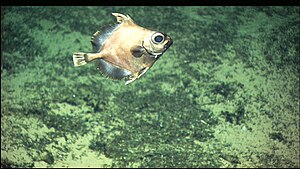Oreosomatidae
| Oreosomatidae | ||||||||||||
|---|---|---|---|---|---|---|---|---|---|---|---|---|

Neocyttus helgae |
||||||||||||
| Systematics | ||||||||||||
|
||||||||||||
| Scientific name | ||||||||||||
| Oreosomatidae | ||||||||||||
| Bleeker , 1859 |
The Oreosomatidae ( Gr . Oreos = mountain, Soma = body) are a little known family of St. Peter's fish-like (Zeiformes). The fish live benthopelagically in the Atlantic , Indian Ocean , Pacific and around the Antarctic over the continental slopes at depths of 400 to 1800 meters. The main area of distribution is in the southern hemisphere off South Africa and southern Australia . They feed on crustaceans , smaller fish, and small cephalopods . They are fished commercially in Japan, Australia and New Zealand.
features
The Oreosomatidae are 21 to 68 centimeters long. Their color is darkly silvery. Your body is high and heavily flattened on the sides. The standard length is 1.4 to 1.9 times the body height. The head length is up to a third of the standard length. The eyes are very large and reach a third to half the diameter of the head and twice to three times the length of the caudal stalk. The region between the eyes is wide and flat. The mouth stands up, the upper jaw can be strongly extended (protractile). There are a row or two of small teeth in the jaws. The number of Branchiostegal rays is seven. The fish have small, overlapping cycloid scales or ctenoid scales , also on the sides of the head. The gill cover is scaly. The lateral line organ is continuous and is accompanied by 84 to 110 pored scales. It does not extend to the tail fin stalk.
Fins formula : dorsal V – VIII / 28–36, anals II – IV / 26–33, ventral I / 5–7, pectorals 17–22
The caudal fin is small and rounded. It is supported by eleven branched fin rays. The tail fin stalk is narrow and short. The pectoral fins reach a third of the length of the head. Their fin rays, like those of the dorsal and anal fin, are undivided. The pelvic fins are supported by a spine and five or six branched fin rays.
The pelagic juvenile fish are very different from the adult fish. They are oval in shape, have a leathery skin and large hardened scales or protruding, scaly areas on the sides of the body. They often reach lengths of 10 to 13 centimeters before they take on the body shape of the adult animals. They used to be considered a separate species.
Systematics
There are ten species in four genera and two subfamilies:
- Subfamily Oreosomatinae
- Genus Allocyttus
- Allocyttus folletti Myers, 1960
- Allocyttus guineensis Trunov & Kukuev, 1982
- Allocyttus niger James, Inada & Nakamura, 1988
- Allocyttus verrucosus (Gilchrist, 1906)
- Genus Neocyttus
- Neocyttus acanthorhynchus Regan, 1908
- Neocyttus helgae (Holt & Byrne, 1908)
- Neocyttus psilorhynchus Yearsley & Last, 1998
- Neocyttus rhomboidalis Gilchrist, 1906
- Genus Oreosoma
- Oreosoma atlanticum Cuvier, 1829
- Genus Allocyttus
- Subfamily Pseudocyttinae
- Genus Pseudocyttus
- Pseudocyttus maculatus Gilchrist, 1906
- Genus Pseudocyttus
literature
- Joseph S. Nelson : Fishes of the World , John Wiley & Sons, 2006, ISBN 0-471-25031-7
- Kurt Fiedler: Textbook of Special Zoology, Volume II, Part 2: Fish . Gustav Fischer Verlag Jena, 1991, ISBN 3-334-00339-6
- PC Heemstra: Oreosomatidae. Pages 1212 to 1213 in FAO Species Identification guide for Fishery Purposes: The Living Marine Resources of the Western Central Atlantic, Volume 2 Bony fishes part 1 (Acipenseridae to Grammatidae) , ISSN 1020-6868
- Eschmeyer, Herald, Hamann: Pacific Coast Fishes , Peterson Field Guides, ISBN 0-395-33188-9
Web links
- Oreosomatidae on Fishbase.org (English)


